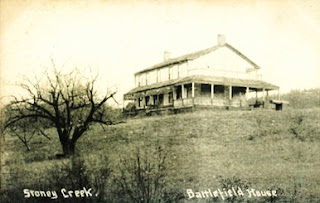Stoney Creek Battlefield - 1899
From just after dawn, Wednesday, August 9,
1899, the bee in aid of the Stoney Creek Battlefield project was in full swing:
“At an early hour, and later during the day,
as required, twelve teams, loading plows or scoops, and a contingent of
thirty-six stalwart men, many of whom were the representatives of U.E.L.
families in the county, set to work to
transform the fruit orchards surrounding the old Gage homestead, of 1812-13
memory into a public park.
“All small fruits and undergrowth have been
cleaned and, when entirely completed, there will be three natural terraces,
from which, as a crown, the site in pre-eminent and commanding fitness, will
raise its head, a spot from which at night the electric lights of Hamilton,
Guelph, Toronto and St. Catherines are to be seen exchanging friendly greetings
with one another.”1
1 Citation incomplete –need to check
with HPL – from one of the Gardiner Scrapbooks.
The day before the Bee, there was nearly a
second major battle on the old Gage property when the representative of the
Women’s Wentworth Historical Society arrived to take possession of the house.
Mr. D.A. Fletcher, who was still residing in the western portion of the old
house, said that he could not vacate because his daughter was ill. It was
hinted that the new house he was building for him and his family was not yet
completed and that he needed more time before he could move. Suitable
arrangements were, at length, agreed upon.
The Bee ultimately attracted over 50 helping
hands, men and boys, who cleared the land, and laid out cricket, lawn tennis
and croquet courts. While the work was in progress, a reporter from the Herald
climbed up the escarpment behind the house and described what he saw as follows
:
“The extended ground occupied by the
Americans appears as an unequalled bird’s eye view. First, from the outposts at
the church, now in ruins, where fifty of the enemy were captured and taken
prisoners; the now white-capped cemetery, in which many of the brave dead, on
both sides lie peaceably at rest side by side, in the still uncared-for
trenches so hurriedly dug and filled on the 6th and 7th
of June.
“Second, the house occupied by the American
generals, built on one of the many natural terraces formed by the Niagara
escarpment; the house, then a log one, still bears marks of the conflict which
raged around it; the rising ground to the east and the barn within a few paces
of the house, were covered that dark night by weary men who lay with their arms
in readiness, from which resting places they were so rudely awakened and put to
flight, leaving their baggage behind them.
“Third, the knoll, where American guns were
so pluckily captured by Col. Penderloathe and his handful of Forty-Ninth
soldiers, lies at our feet to the northeast.
“Fourth, beyond due north, the waters of
Ontario give a streak of purple coloring to the distant horizon – the waters on
which Admiral Yeo and his small fleet appeared the following day in full
pursuit of the fleeing foe.”2
2 Stoney Creek Battlefield : Busy
Workers Transform the Portion Received Bought Into a Park”
Hamilton Herald. August 10, 1899 (foot note needs a check)
After the volunteers had put in a full day’s
work on the battlefield grounds, they were served dinner and tea in the living
room of the old Gage house.



Comments
Post a Comment